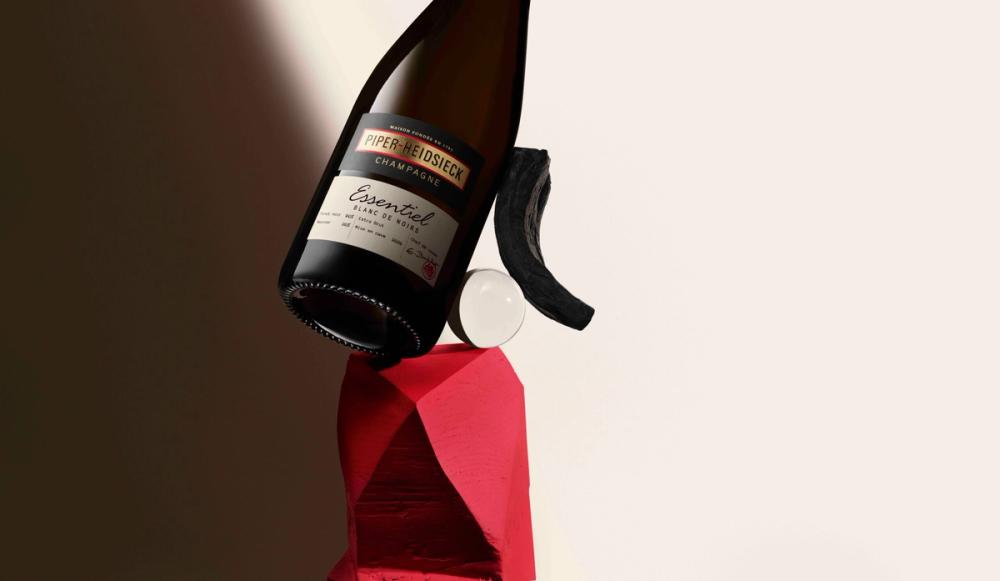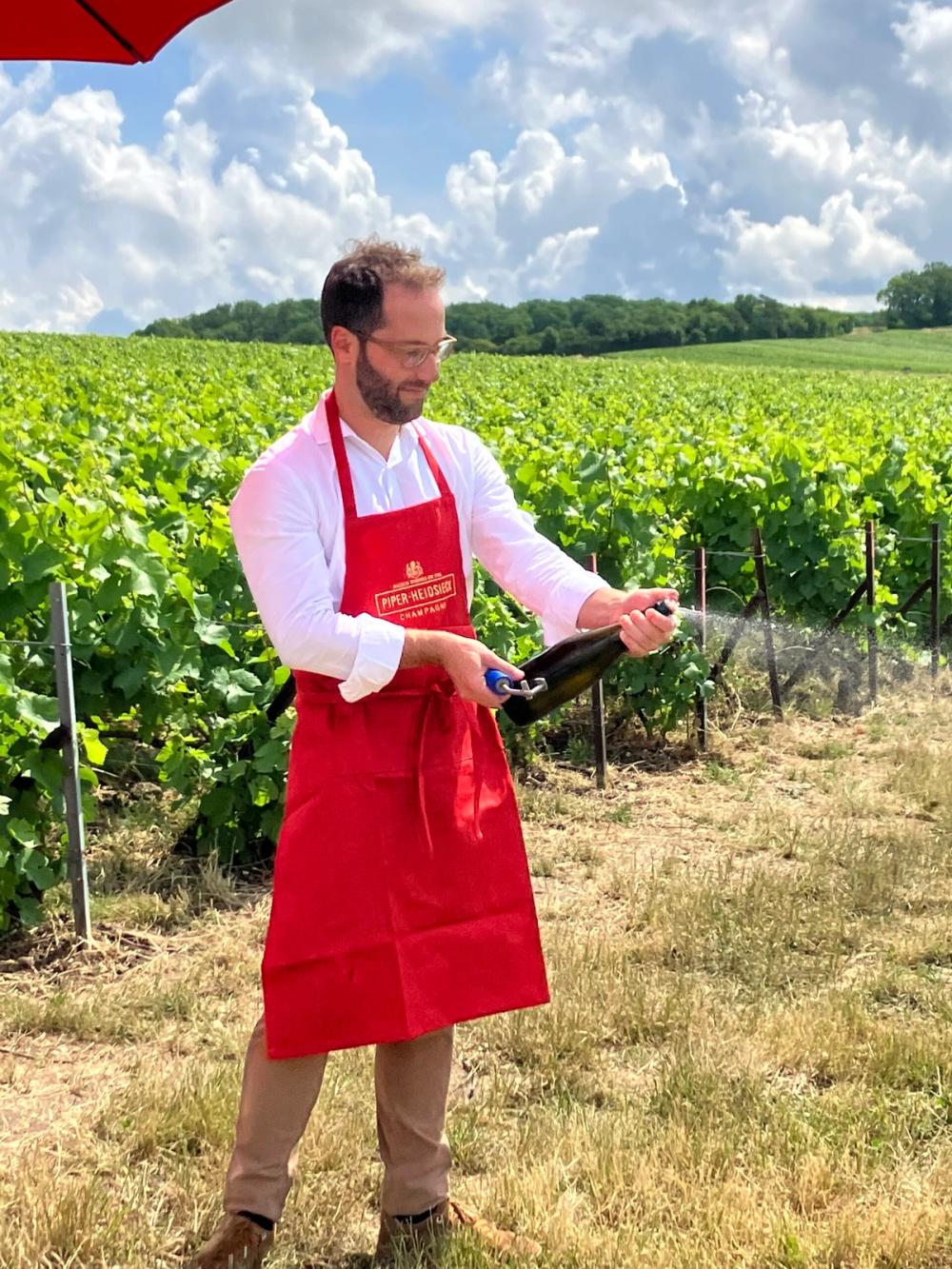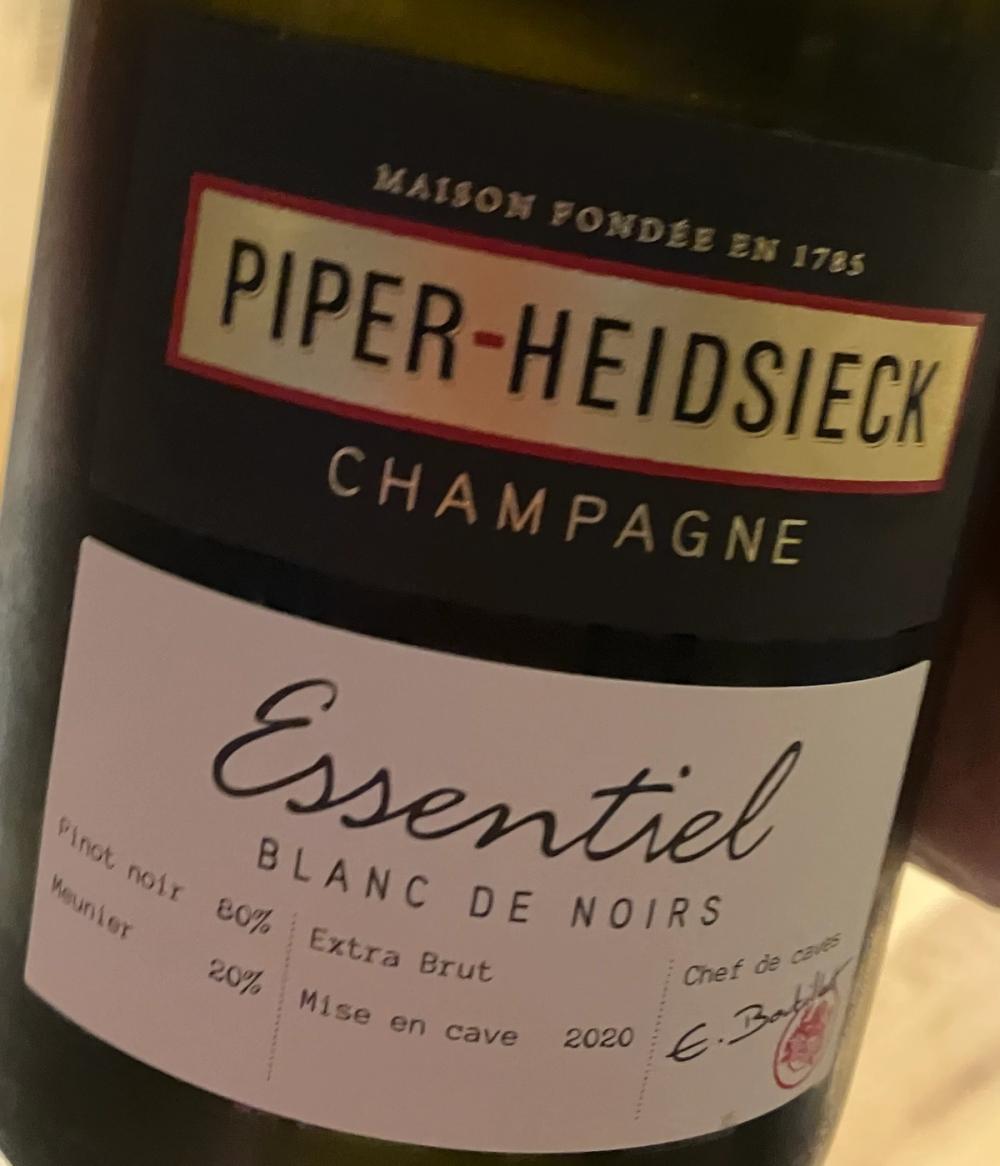“Paradoxically, keeping that style consistent year after year is only possible if you reinvent yourself. Adapting our viticulture, our ripeness targets, and our winemaking to the ‘new normal’ of climate change allows us to preserve our style,” says Boutillat.

Publicity shot of the new Piper-Heidsieck Essentiel Blanc de Noirs
Émilien Boutillat, chef de caves of both Piper-Heidsieck and Rare Champagne, is a unique character. Born in May 1987, he is currently one of the youngest chefs de caves in Champagne, and certainly the only one to be at the helm of one of the most iconic houses in Champagne (Piper-Heidsieck was founded in 1785) at the relatively young age of only 36 years old.
Upon his arrival in October 2018 as chief winemaker of Piper-Heidsieck and Rare Champagne, Boutillat advocated almost immediately that both environmental and social issues were crucial topics to address, spearheading a three-year campaign that resulted in Piper-Heidsieck, Charles Heidsieck & Rare Champagne being named the very first three houses in Champagne to achieve B Corp certification in July 2022. An old soul with a modern vision, Boutillat is fond of saying that the B Corp certification was not just a one-off but an invitation to continue to improve, year after year. He’s not afraid to ask himself difficult questions – and he’s not afraid to innovate, both in the vineyards and in the winery. So befits the chef de caves of Piper-Heidsieck.
Many of Boutillat’s experiments take place in the village of Courmas, located in the Parc Naturel de la Montagne de Reims where Piper-Heidsieck owns 16 hectares of vineyards. As a long-time proponent of biodiversity in the Champagne region, Piper-Heidsieck recently commissioned NaturAgora, founded by Evelyne Ratte in 2006, to analyse its individual plots in Courmas, resulting in a complete inventory of all flora and fauna. ‘Ecological connectivity’ supports biodiversity and facilitates shifts in the ranges of plants, animals, and natural communities in response to environmental and climate change. “A vineyard is an ecosystem in its own right,” says Boutillat.
Piper-Heidsieck was also one of the very first houses in Champagne to begin using a vineyard robot created by VitiBot, a company founded by Cédric Bache in 2016, called Bakus – a completely autonomous tractor able to work up to 10 hours a day powered solely by electricity.

Bakus in the Piper-Heidsieck vineyards
Boutillat is also experimenting with Voltis, a grape variety relatively unknown in the region that was recently authorised by the INAO to be planted in Champagne starting in 2023 on an experimental basis. Early evaluation of Voltis suggests that it is more resistant against fungal diseases (mildew and powdery mildew), a key learning that could greatly reduce phytosanitary treatments in the vineyard moving forward.
Last week a handful of people from around the world were invited to spend 24 hours with Émilien Boutillat and his team at Piper-Heidsieck in Reims. In addition to learning more about the innovations taking place in the vineyard, guests were invited to try the very first new cuvée entirely created and crafted by Boutillat: Piper-Heidsieck Essentiel Blanc de Noirs.
Émilien Boutillat explains the strategy behind the new cuvée

Emilien Boutillat disgorging in the vineyard
The Buyer: You have just introduced the first new cuvée in the Piper-Heidsieck range entirely conceived by yourself since you joined the house as chef de caves in October 2018. Why did you choose Essentiel Blanc de Noirs to be that cuvée?
Émilien Boutillat: The style of Piper-Heidsieck has always been intimately linked to Pinot Noir and to Meunier. Our two emblematic cuvees, Piper-Heidsieck Cuvée Brut and Piper-Heidsieck Essentiel, are both made with nearly 80% of black grape varieties. For me, it was therefore obvious given the history of the house and its connection to Pinot Noir and Meunier that I found the inspiration to create Essentiel Blanc de Noirs. I also wanted to place this new cuvée in the context of the modern and vibrant style of Piper-Heidsieck. Essentiel Blanc de Noirs is a cuvée that combines the great personality of Pinot Noir and the delicacy of Meunier with the freshness and elegance of our house style.
Entirely composed of grapes from VDC-certified vineyards (sustainable viticulture in Champagne), Essentiel Blanc de Noirs also illustrates the commitment of Piper-Heidsieck’s holistic 360° approach to sustainability.
Inspired by Piper-Heidsieck’s history and style with a nod towards our bright and sustainable future, Essentiel Blanc de Noirs is a symbol of Piper-Heidsieck’s philosophy. Since 1785, Piper-Heidsieck has never ceased to innovate and reinvent itself.
The Buyer: Last week guests had the chance to taste nearly 40 years of non-vintage blends (Cuvée Brut and Essentiel Brut) made by four different chefs de caves (Claude Demière, Daniel Thibault, Régis Camus, and yourself), under three different owners (François de Suarez d’Aulan, Rémy Cointreau, and EPI, the current owner since 2011). Houses in Champagne often talk about a “consistent house style” but over the last 40 years there have been many changes, especially in relation to climate, vineyard management, and technology in the winery. All of that said, what do you think is most consistent about the Piper-Heidsieck house style, year after year?

Piper-Heidsieck winery
Émilien Boutillat: I was invited to join a vertical tasting of these four decades of non-vintage cuvées with the winemaking team when I first joined Piper-Heidsieck in 2018. This is the perfect tasting to really engage with the style of Piper-Heidsieck, both in terms of its freshness and its potential for ageing, and to intimately understand the history of its wines throughout the years.
To my eyes, the vibrancy of the fruit is what characterizes the Piper-Heidsieck style. Paradoxically, keeping that style consistent year after year is only possible if you reinvent yourself. Adapting our viticulture, our ripeness targets, and our winemaking to the « new normal » of climate change allows us to preserve our style. To give you some examples, since 2019 we started to block some malolactic fermentation to preserve the acidity, the tilling in the vineyards also push the roots to go deeper and it has a direct effect on the pH…
In addition to constantly questioning ourselves, consistency is also possible thanks to the long-term partnerships we have built with all of our growers located everywhere in Champagne (some of them have worked with us for more than 50 years), thanks to the dedicated winemaking team working with me (both Myriam Faure-Brac and Dominique Dufour have been part of the winemaking team for more than 30 years), thanks to the modern and stainless steel winery we built in 1995 (allowing us to separate and preserve the expression of each terroir)…
The Buyer: What are the 10 villages that make up the Essentiel Blanc de Noirs? Why is there a cooler climate in the Côte des Bar even though the vineyards are located approximately 150 kilometres to the south of Reims?
Émilien Boutillat: Essentiel Blanc de Noirs is a blend of the best terroirs of Pinot Noir and Meunier in Champagne. The 80% of Pinot Noir comes from the Montagne de Reims (Ambonnay), the Grande Vallée de la Marne (Aÿ) and the Côte des Bar (Fontette, Meurville, Neuville-sur-Seine) whereas the 20% of Meunier comes from the villages of Cormicy, Courmas, Verneuil, Cuchery, and Villevenard.
The climate depends on many parameters, primarily temperature, rainfall, exposition, altitude, and slope. To achieve the freshness, vibrancy, and salinity of Piper-Heidsieck’s style, I selected grapes from cooler climates such as Cormicy, Courmas and Fontette. The latter village, Fontette, is an excellent example of a cooler climate in the Côte des Bar. The vineyards there benefit from a microclimate linked with an exposition that preserves the acidity and the crispiness in the wines.
As we are more and more impacted by the climate change, this type of cooler terroir is becoming more and more interesting to preserve the freshness in the blends and the vibrancy of our style.
A preview of Piper-Heidsieck Essentiel Blanc de Noirs with a lot of style

Emilien Boutillat and Nicolas Sale at the launch of the new cuvée
Last week’s preview of Piper-Heidsieck Essentiel Blanc de Noirs in Reims culminated in a sumptuous dinner prepared by Chef Nicolas Sale (The Ritz, Le Meurice) in the Piper-Heidsieck winery paired alongside other celebrated cuvées such as Essentiel Blanc de Blancs, Hors Série Vintage 1982, and Rosé Sauvage.
In celebration of the 10 crus that make up Essentiel Blanc de Noirs, 10 classical musicians performed a unique composition written by Antoine Berquet as the new cuvée was revealed in the winery.

Piper-Heidsieck Essentiel Blanc de Noirs is available in the United Kingdom through Liberty Wines, in Australia through Oatley Fine Wines, and in the United States through Folio Fine Wine Partners.






























